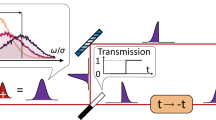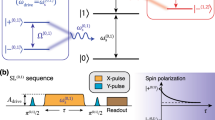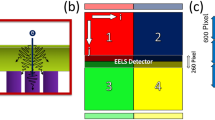Abstract
IN a recent communication, Kent and Mallard1 pointed out that the versatility of an electron spin resonance-spectrometer can be considerably improved by combining it with an analogue digital converter and a commercial multichannel analyser as they are commonly used in nuclear spectroscopy. We have used a similar piece of equipment, and have already presented a preliminary report2. The basic technique was introduced by Klein and Barton3. It should be noted that any real improvement is based on the fact that the noise seen in electron spin resonance-spectra is not ‘white noise’. That is to say that the probability for a certain frequency to occur in the noise-spectrum is not equal for all frequencies, but is enhanced for lower values3. It is therefore clear that no higher sensitivity can be achieved if the time constant of the amplifier and the recording time are enhanced above a certain limit being about 100 sec for the time-constant4. The sensitivity is restricted, for example, by instabilities of the whole equipment. This applies to relatively long times of measurement. If the recording time is short, a sampling procedure as described by Kent and Mallard1 is not expected to bring any improvement if the time-constant is correctly adjusted. Thus the sub-division of one measurement into ten single ones appears to offer no advantage and the same result may be obtained by increasing the apparatus time constant or by repeating ten times the recording of the whole spectrum at a higher speed. The basic law of communication theory, namely, that any improvement in signal-to-noise ratio requires an increase in time of measurement, cannot be overcome by any of these methods.
This is a preview of subscription content, access via your institution
Access options
Subscribe to this journal
Receive 51 print issues and online access
$199.00 per year
only $3.90 per issue
Buy this article
- Purchase on SpringerLink
- Instant access to full article PDF
Prices may be subject to local taxes which are calculated during checkout
Similar content being viewed by others
References
Kent, M., and Mallard, J. R., Nature, 207, 1195 (1965).
Kiefer, J., and Neubacher, H., paper read at the Second Symposium on Electrochemical Methods in Biology, Jena, April 1965 (to be published in Abhandl. Deutsche Akad. Wiss.).
Klein, M. P., and Barton, G. W., Paramagnetic Resonance, edit. by Low, W., 698 (Academic Press, 1963); Rev. Sci. Instrum., 34, 754 (1963).
Schneider, F. (personal communication).
Author information
Authors and Affiliations
Rights and permissions
About this article
Cite this article
KIEFER, J., NEUBACHER, H. On the Combination of an Electron Spin Resonance Spectrometer and a Multichannel Analyser. Nature 209, 1343 (1966). https://doi.org/10.1038/2091343a0
Issue date:
DOI: https://doi.org/10.1038/2091343a0



